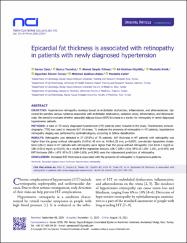Epicardial fat thickness is associated with retinopathy in patients with newly diagnosed hypertension

Göster/
Erişim
info:eu-repo/semantics/openAccessTarih
2021Yazar
Özer, SavaşYücekal, Burcu
Yücel, Ahmet Seyda
Özyıldız, Ali Gökhan
Kınık, Mustafa
Turan, Oğuzhan Ekrem
Aslan, Mehmet Gökhan
Çetin, Mustafa
Üst veri
Tüm öğe kaydını gösterKünye
Ozer, S., Yucekul, B., Yilmaz, A. S., Ozyildiz, A. G., Kinik, M., Turan, O. E., Aslan, M. G., & Cetin, M. (2021). Epicardial fat thickness is associated with retinopathy in patients with newly diagnosed hypertension. Northern clinics of Istanbul, 8(4), 365–370. https://doi.org/10.14744/nci.2020.23334Özet
OBJECTIVE: Hypertensive retinopathy develops based on endothelial dysfunction, inflammation, and atherosclerosis. Epicardial fat secretes various cytokines associated with endothelial dysfunction, oxidative stress, inflammation, and atherosclerosis. We aimed to evaluate whether epicardial adipose tissue (EAT) thickness is a marker for retinopathy in newly diagnosed hypertensive patients.
METHODS: A total of 73 newly diagnosed hypertension (HT) patients were included in the study. Transthoracic echocardiography (TTE) was used to measure EAT thickness. To evaluate the presence of retinopathy in HT patients, hypertensive retinopathy staging was performed by ophthalmologists, according to Scheie classification.
RESULTS: Retinopathy was detected in 27 (37.0%) of 73 patients. EAT thickness in HT patients with retinopathy was higher than the group without retinopathy (5.07 +/- 1.45 mm vs. 4.19 +/- 1.20 mm, p=0.007). Low-density lipoprotein cholesterol (LDL-C) levels in HT patients with retinopathy were higher than the group without retinopathy (162.4 +/- 41.2 mg/dl vs. 138.1 +/- 35.6 mg/dl, p=0.010). As a result of the regression analysis, LDL-C (OR=1.016, 95% CI 1.001-1.031, p=0.043) and EAT thickness (OR=1.674, 95% CI 1.069-2.626, p=0.043) were the independent predictors of retinopathy.
CONCLUSION: Increased EAT thickness is associated with the presence of retinopathy in hypertensive patients.

















